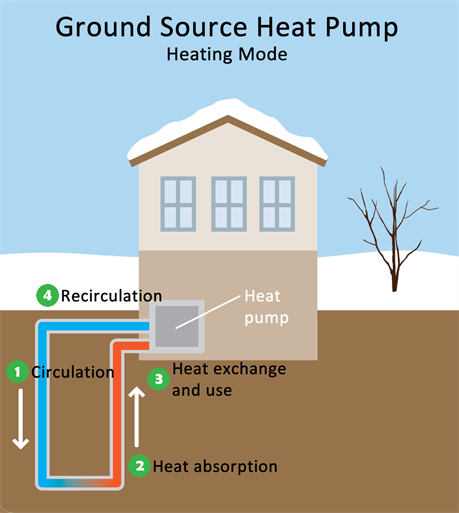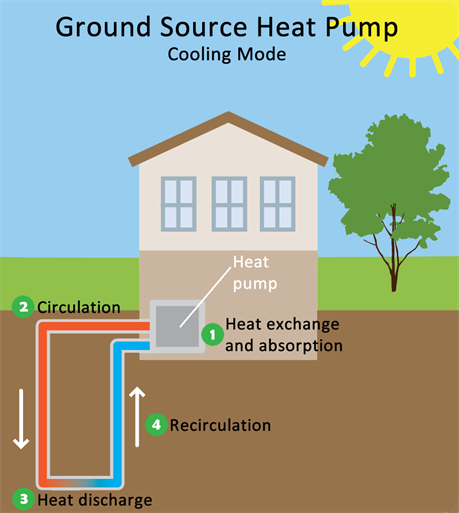What is Geothermal Heating and Cooling?
Geothermal systems provide heating and cooling by exchanging heat with the ground through a system of fluid filled underground pipes. The ground temperature remains relatively constant throughout the year at around 55ᵒF, which allows geothermal systems to both heat and cool buildings by pulling heat from the ground for heating during the winter and removing heat from indoor spaces and storing it in the ground for cooling during the summer. Above ground, geothermal heat pumps that are connected to the underground pipes help transfer heat between the fluid in the pipes and the air. In most cases, these heat pumps are connected to conventional ductwork to distribute heated or cooled air within the building. Learn more about the
types of geothermal heat pump systems.


Images courtesy of U.S. Environmental Protection Agency
Benefits of Geothermal Heating and Cooling
Improved efficiency
Since a geothermal system is moving heat around instead of creating heat, geothermal systems are much more efficient than other heating and cooling options, reaching efficiencies of 300% to 400%. In other words, for each unit of energy the system uses, it produces three to four units of heating or cooling. This is compared to traditional options (e.g., furnaces) that have maximum efficiencies of around 96%, using more energy than the amount of heating or cooling they provide. As a result, geothermal systems use much less energy than other heating and cooling options, reducing energy costs while improving comfort.
Reduced energy and replacement costs
The increased efficiency of geothermal systems results in the use of less energy to heat and cool a space, meaning that geothermal systems have some of the quickest payback periods, with many seeing their costs fully recovered in five to ten years depending on the cost of energy and incentives used for installation. Additionally, most geothermal
system life spans are estimated around 24+ years for the geothermal heat pump and 50+ years for the ground loop. Given that a geothermal system acts as both a heating and cooling system, and the average system life for both a
furnace and an
air conditioner is 15-20 years, geothermal systems last longer and save money on replacement costs over the lifetime of the system. This is in addition to the energy savings achieved from the increased efficiency of the system compared to traditional systems.
Reduced emissions
Because geothermal systems use the ground to provide heating and cooling, they use 25% to 50% less electricity than other systems, greatly
reducing greenhouse gas emissions. Geothermal systems further reduce greenhouse gas emissions and create more healthy spaces because they eliminate the need for fossil gas heating, which is a major source of
greenhouse gas emissions in Ann Arbor, and is known to generate
air pollutants in indoor spaces that cause health issues such as asthma, allergies, and learning deficits. While geothermal systems do require a small amount of electricity to operate, as the electric grid becomes cleaner with more renewables, geothermal systems have the potential to provide heating and cooling with zero emissions.
Increased comfort
Geothermal heat pumps hold a
consistent temperature and can
maintain consistent indoor humidity levels, resulting in comfortable indoor environments. The system is also very quiet and produces no indoor air pollution.
What is District Geothermal?

Image courtesy of
HEET.
While geothermal systems can be designed to serve an individual household or building, they can also be designed to serve multiple households or buildings through a system called district geothermal.
As with individual geothermal systems, district geothermal can provide heating and cooling by exchanging heat with the ground through a system of fluid filled underground pipes. However, in the case of district geothermal, the system of underground piping is much larger and connected to multiple households or buildings to meet their heating and cooling demands. Each home or building in the system has its own geothermal heat pump that connects to the underground geothermal loop, allowing it to transfer heat between the home or building and the overall system. As each building has different heating/cooling needs, the heat is transferred and shared between them depending on each building's unique circumstance, meaning energy is never wasted. Any excess heat is simply stored in the ground until it is needed.
Benefits of District Geothermal
As with individual geothermal systems, district geothermal is a much more efficient heating and cooling system than other systems, meaning lower energy bills for everyone served by the system and less greenhouse gas emissions. Additionally, because this system is all electric, it helps eliminate the need for fossil gas heating systems, further reducing greenhouse gas emissions as well as reducing air pollutants in our indoor spaces that cause health issues. In addition to the general benefits of geothermal heating and cooling, district geothermal also sees the following benefits:
Reduced cost of installation per customer
Since the underground loop is already installed and shared by all, each customer – be it a business, a home, or a government building – joining the system only has to account for the equipment in their home or building and their portion of the shared system. This significantly lowers the upfront cost of accessing geothermal!
System balancing
As the system grows, it is easier to balance the temperature of the system as different parts of the system use energy at different times and in different amounts, meaning these systems can be even more efficient, with some systems reaching
efficiency levels over 500%. This means that district geothermal can produce five or more units of heating and cooling for each unit of energy the system uses! The more diverse the system, the less likely all the heating or cooling peak demands will occur at the same time, resulting in a more efficient system.
Jobs and the energy transition
District geothermal provides an opportunity to
create and maintain local, good-paying jobs in the energy industry. Since district geothermal is essentially a network of pipes connecting to homes and buildings, the system is similar to existing fossil gas infrastructure, meaning the skillset required is already present in our workforce with an opportunity to continue growing. And since the system requires physical infrastructure in the community, the jobs are inherently local. As we work to transition to carbon-free heating and cooling options, district geothermal provides an opportunity for existing companies and workers to transition their business model and bring in highroad jobs to the community while we all work to achieve a just transition to community-wide carbon neutrality by 2030. Learn more about how geothermal can help increase the number of high-paying union jobs in Ann Arbor.
Geothermal in Ann Arbor

Freehand sketch by Priyanshi Soni, Image Courtesy of IMEG
The City of Ann Arbor is actively considering the viability of district geothermal in our community. In 2023, Ann Arbor was
awarded funding to design a district geothermal loop around the Bryant Elementary School, including the 262 homes in the neighborhood and the Bryant Community Center, and conduct test boring to test the feasibility of the design. Over the past year, OSI has been working closely with its partners and members of the community to create a feasible design, with initial results showing great promise. In October 2024, OSI will be able to apply for additional funding to install the system.
Additionally, the City is looking for other areas in the community that could be a good fit for district geothermal, including the neighborhood directly adjacent to Veteran's Memorial Park. In 2024, OSI began working with Stantec to assess the feasibility of district geothermal across Ann Arbor. Using the results, OSI and Stantec will select up to three areas to do a more in-depth feasibility study. Learn more about the work OSI is doing with Stantec to study the feasibility of district geothermal in Ann Arbor from a recording of the Ann Arbor Energy Commission's Aug. 2024 meeting.
Updates on the City's district geothermal work will be posted on this page and in the
Office of Sustainability and Innovations Newsletter.
District Geothermal in Other Communities
Additional resources
